This was published 1 year ago
Struggle over gun led to missing campers’ accidental deaths: defence
By Erin Pearson
The murder trial of Gregory Lynn, a former Jetstar pilot accused of killing two campers in 2020, has begun in the Supreme Court of Victoria.
Prosecutors claim Lynn killed Carol Clay and Russell Hill at a remote campsite before dumping their bodies and burning evidence.
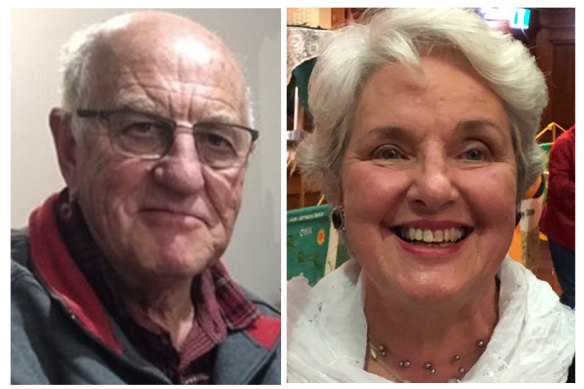
Russell Hill and Carol Clay.
But Lynn’s defence team argues the deaths were accidental and that Clay was shot when the two men struggled for control of a gun, and Hill was stabbed during a subsequent tussle over a knife.
Scroll down for regular updates on day one of the trial.
‘Russell, stop it’: Lynn’s explanation of what happened
Lynn’s defence team claims the missing campers’ deaths were tragic accidents.
“Tragic accidental deaths in circumstances which were not of Lynn’s making and not of his choosing,” are the words defence barrister Dermot Dann, KC, used before a jury of 15 on Tuesday.
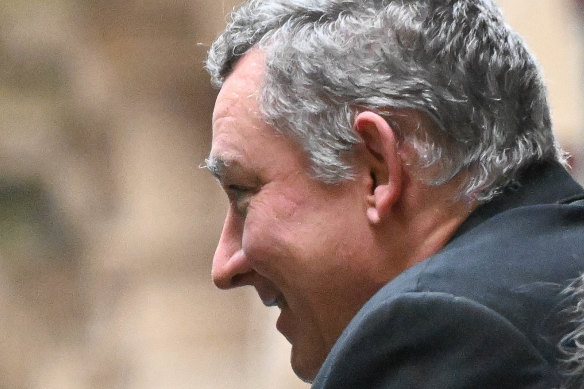
Gregory Lynn outside the Supreme Court.Credit: Joe Armao
Dann said that when Lynn, 57, first met Hill and Clay at a campsite in the Wonnangatta Valley in the state’s alpine region, they exchanged pleasantries.
But the next day, on March 20, 2020, Lynn went hunting, and when he returned to Bucks Camp, he became aware of a drone flying above him.
Lynn had concerns about Hill’s drone, Dann told the court. Hill, in turn, had concerns about Lynn – Hill thought that he’d been hunting too close to where they all were camping.
Hill was particularly uneasy about it, the court heard, because a deer hunter had accidentally killed his relative.
“As this conversation went on after dinnertime, Mr Lynn was accused by Mr Hill of hunting too close to the campsite,” Dann told the jury. “Mr Hill said he had footage of Mr Lynn hunting too close to the campsite and was going to take the footage to police.”
According to the defence, Lynn told Hill “he was speaking nonsense” and walked back to his own campsite nearby.
He had dinner, then went to the car and turned the stereo on up high, with the car door open. He had intended to annoy Hill.
Later, about 9pm or 10pm, Dann told the court, Lynn allegedly became aware of some noise around his own car.
Then Lynn had seen Hill walking away from the car, the court heard, having taken a magazine of ammunition and his gun.
“Mr Lynn started to follow Mr Hill ... could see him trying to load the magazine. Mr Lynn asked what he was doing, asked him to give his gun back, and Mr Hill told him to f--- off. Mr Hill lost his temper.
“The loud music had obviously disturbed him,” Dann said.
“Mr Hill said he was going to take the gun to the police as well.”
Dann said Lynn then went towards Hill to get his gun back, when Hill fired the gun into the air, leaving Lynn “scared shitless”.
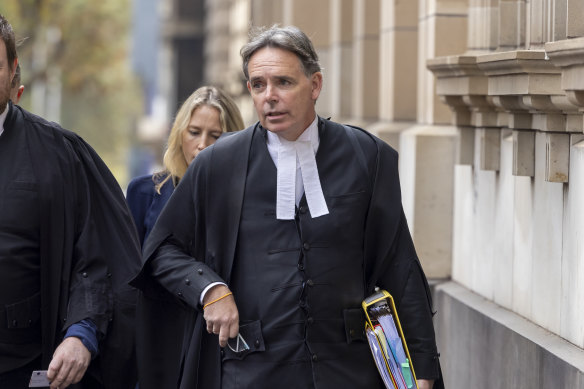
Defence barrister Dermot Dann, KC.Credit: Wayne Taylor
“What followed was a struggle for control of the gun ... near the front of Mr Hill’s car,” the barrister said.
Dann said it was a chaotic scene, with Clay yelling out: “Russell, stop it.”
But as the struggle allegedly continued, Dann said, a shot went through the mirror of Hill’s car and then allegedly struck Clay in the head.
“It’s the defence case Mr Hill let go of the gun, Mr Hill went over to see where Mrs Clay was.”
Dann said Lynn got his gun back and returned to the car before Hill came towards him with a knife, “screaming at him, ‘She’s dead.’ “Then a struggle occurred over the knife.
“The two men fall to the ground and the knife goes through the chest of Mr Hill.”
Dann said his client then made a series of terrible choices, fearing his life would be “screwed”.
He said there was no dispute over the fact his client then moved the bodies using his trailer to Union Spur Track, where he repeatedly returned.
In November 2020, Lynn says, he burnt the bodies he had left.
“He describes burning those bodies, being physically sick. He describes scooping the remains up from the fire ... and depositing the remnants of the fire nearby,” Dann said.
Dann said it would now be up to the prosecution to dispute Lynn’s account.
The prosecution rejects Lynn’s version of events and says Hill and Clay were killed with murderous intent.
Russell Hill probably killed first, Carol Clay shot in head: prosecutor
Lynn is said to have arrived at the campsite on March 18, 2020, after a Parks Victoria contractor in the valley suggested it was a good spot.
Hill set off from his home on March 19, telling his wife, Robyn, that he planned to be gone for at least a week.
Clay told friends she was heading out of town for a couple of days and would not be contactable by phone.
Hill and Clay then headed off together and were seen in the valley about 3.30pm that day. They set up camp at Bucks Camp near Lynn.
At 6pm Hill radioed his friends to let them know he was at Wonnangatta. He did so again at 8am.
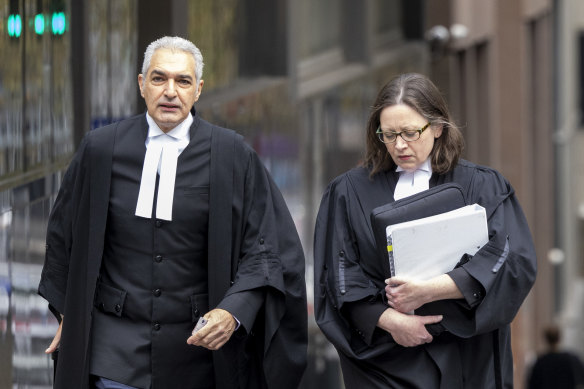
Crown prosecutors Daniel Porceddu and Kathryn Hamill arrive at court.Credit: Wayne Taylor
Nothing of note was discussed. Later that day, about 5pm, another camper reported seeing Hill’s drone flying over his campsite.
The last radio contact anyone had with Hill was between 6pm and 6.40pm.
“Nothing seemed out of the ordinary with Mr Hill,” Crown prosecutor Daniel Porceddu said.
“It’s alleged that during the evening of Friday, March 20, 2020, at Bucks Camp, the accused murdered Mr Hill and Mrs Clay.
“The precise circumstances of the killing are not known. Nor is the motivation.
“The prosecution alleges that all the relevant circumstances, including the violent deaths of the two people in close proximity, point to Mr Hill and Mrs Clay each being killed deliberately and without lawful justification.
“Given the later removal from the scene of Mr Hill’s drone and the mobile phones, it’s likely there was a dispute regarding Mr Hill’s drone or vision captured on his drone.
“There might have been an argument or confrontation between the men.
“It is not known how Mr Hill was killed. The prosecution alleges that Mr Hill was most likely killed first, in part because Mrs Clay is very unlikely to have provoked a violent confrontation involving a firearm or posed any threats to the accused.”
While the cause of Hill’s death is unknown, the prosecutor said it was alleged that Lynn shot Clay in the head while she was crouched down near her tent.
Who were Russell Hill and Carol Clay?
Russell Hill, 74, married to wife Robyn, was a frequent camper and radio enthusiast.
During his camping trips, the prosecution said, Hill would regularly operate his two-way radio and check in at 6pm each night.
Hill, who owned a white 2017 Toyota Landcruiser ute, was not known to have any interest in firearms, but he did own a drone.
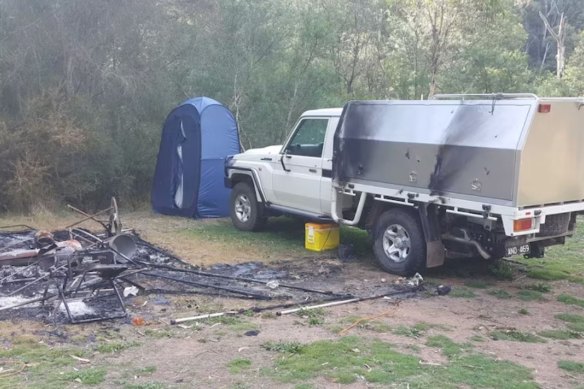
Russell Hill’s Toyota Landcruiser and the burnt campsite at Bucks Camp.Credit: Victoria Police
He also told other campers he encountered in the weeks before his death that he was not a keen hunter and that a relative had been killed while deer hunting.
He told one group of campers that he was unhappy about them camping close to his site.
Pakenham woman Carol Clay, 73, was heavily involved in community organisations including the Country Women’s Association and Red Cross.
The jury was told Clay and Hill had been in a relationship since 2006. Porceddu, the prosecutor, said Hill had been Clay’s first boyfriend.
There is no mobile phone service available in the vast Wonnangatta Valley, which is popular with 4WD enthusiasts, horse riders, campers and hunters.
About 3.30pm on March 19, 2020, campers near Wonnangatta Station Hut drove behind Hill and Clay and saw them stop at Bucks Camp.
Alleged crime scene clean-up
In the aftermath of the deaths, the prosecution says, Lynn went to considerable effort to contaminate the scene and conceal evidence.
He then allegedly set fire to the scene, removed some of Hill’s and Clay’s belongings and drove away with their bodies in his box trailer.
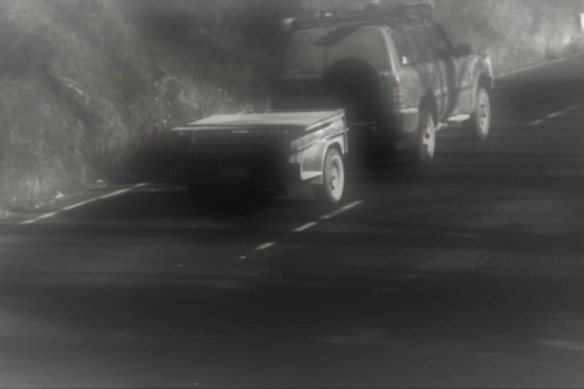
The prosecution alleges Lynn drove away with Hill and Clay’s bodies in a box trailer.Credit: Victoria Police
Witness Tom Matthews told police he woke to the sound of a car towing a trailer and trying to reverse after coming across a closed road. The prosecution alleges Lynn was the driver of the car.
The nearby road was closed, and the driver had to turn around.
The prosecution said Lynn then drove for hours with the bodies on board, to an area called Union Spur Track near the small town of Dargo.
Porceddu said Lynn then hid the bodies in a part of the wilderness to which he would be able to return.
Human remains were later found at that location, including in a tree hole.
Lynn’s 4WD and trailer were later captured by traffic cameras on the Great Alpine Road at Bucklands Gap, about 1.6 kilometres east of Dargo High Plains Road intersection, about 9.48am on March 21, at a similar time to Hill’s mobile phone pinging off a nearby phone tower.
“He [Lynn] did not report the deaths of Mr Hill and Mrs Clay or contact police,” Porceddu said.
On March 21, Hill did not call in on the radio despite often doing so.
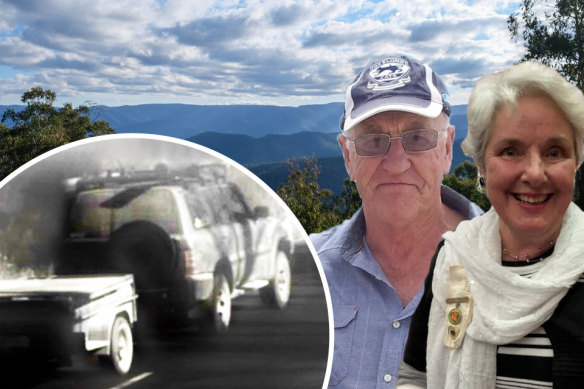
The investigation into the disappearance of Russell Hill and Carol Clay focused on a four-wheel drive.
Other campers later came across the burnt-out campsite at Bucks Camp, where they found items, including a pink handbag on the front passenger seat of a car, a smashed side mirror and an Esky full of food.
On March 26, Robyn Hill reported her husband missing to police.
Police first arrived at the burnt campsite about 12.20pm on March 28, and removed the Landcruiser and other items.
There was a wallet in each foot-well of the vehicle, but no cash, with cards scattered around, the jury heard. Hill’s radio was tested and found to be working.
Despite a two-week search of the area, police found no evidence of Hill and Clay.
On April 1, the prosecution said, Lynn put the trailer and other items up for sale on Gumtree, and the ad was removed two days later. The trailer has never been found.
“The accused is alleged to have disposed of the trailer because it held the bodies of Mr Hill and Mrs Clay, and if found … it might link him to their murders,” Porceddu said.
On April 10, 2020, the missing persons squad was called in to assist with the investigation.
Soon after the first Melbourne COVID-19 lockdown ended, Lynn allegedly returned to the alpine region, leaving home about midnight on May 12, 2020.
Between 5.04am and 12.42pm on May 13, Lynn’s phone made no connection with any phone tower, consistent with him entering remote parts of the alpine region, before returning to Melbourne about 3.48pm.
“It’s alleged the accused returned to the spot where he left the bodies to ensure they were still well hidden,” Porceddu said.
Police investigation
During a visit to Lynn’s home on June 4, 2020, missing persons squad detectives found he had painted his dark grey car beige, allegedly “to avoid his car being identified by authorities”.
An analysis of fire debris from Bucks Camp, conducted in January 2021, showed burnt items included bra hooks, camp chairs, a solar panel and a battery.
From September 22, 2021, surveillance devices were installed in Lynn’s home and car, recording his conversations.
“On November 13, 2021, the accused was recorded on a listening device in his home speaking with his wife, Melanie, while they watched a 60 Minutes feature on Mr Hill and Mrs Clay. The accused told his wife there were only four hours in the day when he was in the area where the campers went missing, and how it was not funny,” Porceddu said.
“On November 19, 2021, the accused removed the side awning from his car that was visible in the television program.
“It’s the prosecution case he did so to avoid being linked to the murders.”
After police arrested Lynn, they removed and examined his Nissan Patrol.
Inside were items including hunting gear and a tin of paint. Examinations found the vehicle was originally white and later painted dark grey, then beige.
A 12-gauge bolt-action shotgun was later seized from his Caroline Springs home and analysed.
“The prosecution allege that was a firearm that was used to shoot Mrs Clay in the head,” Porceddu said.
On February 11, 2022, the canopy of Hill’s vehicle was examined. Porceddu said the examining expert found blood splatter stains and fatty deposits under an area of the canopy.
The prosecution alleges DNA analysis supports the proposition that the sample belonged to Clay.
The bodies
The jury was told that in March 2022, police re-examined the Bucks Camp site and discovered metal and bone fragments, including an unburnt skull fragment allegedly belonging to Clay.
It’s the prosecution case that the metal projectile fragment likely came from a 12-gauge shotgun and contained Clay’s DNA. Further fragments of human skull bones, believed to have belonged to Clay, were also later collected from the scene.
Between November 29 and December 1, 2021, forensic experts, anthropologists and police examined a second scene at Union Spur Track, near Dargo.
They found burnt remains while focusing on an area at the base of a fallen tree, the prosecutor said. The remains had included a burnt human tibia, or leg bone, and a toe bone.
The jury was told further remains found nearby included more than 2100 pieces of burnt and highly fragmented bones. A ring discovered at the scene was later found to have possibly belonged to Clay.
Porceddu said examination of the bone fragments “indicated they were from at least two adult humans” and had started to decompose before being moved, burnt and later placed in the tree hole.
DNA analysis found the remains, including five teeth and a porcelain bridge, probably belonged to Hill.
The prosecution alleges Lynn killed the unarmed pair at Bucks Camp voluntarily with murderous intent.
Lynn denies the charges.
The fellow campers
Blair Thomas Anson said that in the week before the alleged murders, he came across Hill camping at King Billy in the Alpine National Park on March 11, 2020.
He and two friends – Chris Benton and Rowan Stewart – set up camp and went to hunt before returning to find Hill camping next to them, and pottering around his site.
The following day, Anson said, he went to introduce himself to the older man, who he noticed had an antenna hung up through a tree which was connected to a UHF radio.
“He asked permission from me if he could fly his drone. I said that’s no problem with me,” Anson told the jury.
“When the others then returned … Russell came over to our camp. I remember leaning on the back of my friend’s ute. We were making coffee and talking.

Blair Anson said he found Russell Hill to be “very approachable”. Credit: Jason South
“We were just asking what he was up there for with the UHF set-up he had. That he wasn’t a hunter, what he did for work before he retired. His car, he spoke highly of his car.”
Anson said Hill was much older than his group of friends but that all three enjoyed talking to him.
“He was a knockabout guy. We found him very approachable.”
Anson said that after later learning Hill was missing, he assumed he might have committed suicide as they had discussed the fact he used to work in the area. It was therefore unlikely that Hill would have become lost, Anson said.
The isolated valley
The first witness in the trial, Parks Victoria chief ranger Michael Dower, is responsible for managing about 350,000 hectares of highly remote mountainous area which includes the Wonnangatta Valley.
“It’s one of the most remote locations in the Victorian Alps landscape,” he told the court.
He said a historic cattle station, an 1800s cemetery and the ruins of the Wonnangatta homestead were situated in the valley.
The valley was surrounded by rugged terrain and closed between the King’s Birthday long weekend and Melbourne Cup Day due to dangerous river heights and snow at Howitt Plains, the court heard.
“The Alpine National Park is one of the largest parks in the country and used for a wide variety of reasons, [including] fishing, deer hunting, bushwalking and nature-loving activities, like bird watching,” Dower said.
“Four-wheel driving in the area is now high-profile, like [in the] Simpson Desert and Cape York.”
At its core, he said, was the Wonnangatta Valley, which could be accessed from Dargo to the east, Licola and Mansfield to the south, and Myrtleford to the north-east.
“The Wonnangatta Valley was originally a cattle-grazing station in the 1800s. It’s a highly remote location. A cattle-grazing property of up to 1000 acres, it was run by several families until it was converted over to the Crown in the late ’80s, early ’90s,” he said.
Dower said licensed recreational hunters were allowed to hunt sambar deer there.
Pointing to maps, Dower said Bucks Camp, also known as Dry River Camp, was a 10 to 15-minute drive from the cemetery.
He confirmed that in March 2020, the route in and out of the valley via Myrtleford was closed due to nearby fire operations.
A new podcast from 9News, The Age and 9Podcasts will follow the court case as it unfolds. The Missing Campers Trial is the first podcast to follow a jury trial in real time in Victoria. It’s presented by Nine reporter Penelope Liersch and Age reporter Erin Pearson.